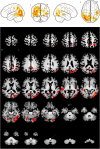Removing outliers from the normative database improves regional atrophy detection in single-subject voxel-based morphometry
- PMID: 38378906
- PMCID: PMC10937771
- DOI: 10.1007/s00234-024-03304-3
Removing outliers from the normative database improves regional atrophy detection in single-subject voxel-based morphometry
Abstract
Purpose: Single-subject voxel-based morphometry (VBM) compares an individual T1-weighted MRI to a sample of normal MRI in a normative database (NDB) to detect regional atrophy. Outliers in the NDB might result in reduced sensitivity of VBM. The primary aim of the current study was to propose a method for outlier removal ("NDB cleaning") and to test its impact on the performance of VBM for detection of Alzheimer's disease (AD) and frontotemporal lobar degeneration (FTLD).
Methods: T1-weighted MRI of 81 patients with biomarker-confirmed AD (n = 51) or FTLD (n = 30) and 37 healthy subjects with simultaneous FDG-PET/MRI were included as test dataset. Two different NDBs were used: a scanner-specific NDB (37 healthy controls from the test dataset) and a non-scanner-specific NDB comprising 164 normal T1-weighted MRI from 164 different MRI scanners. Three different quality metrics based on leave-one-out testing of the scans in the NDB were implemented. A scan was removed if it was an outlier with respect to one or more quality metrics. VBM maps generated with and without NDB cleaning were assessed visually for the presence of AD or FTLD.
Results: Specificity of visual interpretation of the VBM maps for detection of AD or FTLD was 100% in all settings. Sensitivity was increased by NDB cleaning with both NDBs. The effect was statistically significant for the multiple-scanner NDB (from 0.47 [95%-CI 0.36-0.58] to 0.61 [0.49-0.71]).
Conclusion: NDB cleaning has the potential to improve the sensitivity of VBM for the detection of AD or FTLD without increasing the risk of false positive findings.
Keywords: Brain; Magnetic resonance imaging; Neurodegeneration; Normative database; Voxel-based-morphometry.
© 2024. The Author(s).
Conflict of interest statement
We declare that we have no conflict of interest.
Figures






Similar articles
-
Voxel-based morphometry in single subjects without a scanner-specific normal database using a convolutional neural network.Eur Radiol. 2024 Jun;34(6):3578-3587. doi: 10.1007/s00330-023-10356-1. Epub 2023 Nov 9. Eur Radiol. 2024. PMID: 37943313 Free PMC article.
-
Clinical validation of artificial intelligence-based single-subject morphometry without normative reference database.J Alzheimers Dis. 2025 Jan;103(2):542-551. doi: 10.1177/13872877241304607. Epub 2025 Jan 12. J Alzheimers Dis. 2025. PMID: 39801073
-
Dissociating memory networks in early Alzheimer's disease and frontotemporal lobar degeneration - a combined study of hypometabolism and atrophy.PLoS One. 2013;8(2):e55251. doi: 10.1371/journal.pone.0055251. Epub 2013 Feb 14. PLoS One. 2013. PMID: 23457466 Free PMC article.
-
[Neuroimaging in corticobasal syndrome].Rinsho Shinkeigaku. 2013;53(11):1029-32. doi: 10.5692/clinicalneurol.53.1029. Rinsho Shinkeigaku. 2013. PMID: 24291869 Review. Japanese.
-
Comparisons between Alzheimer disease, frontotemporal lobar degeneration, and normal aging with brain mapping.Top Magn Reson Imaging. 2005 Dec;16(6):409-25. doi: 10.1097/01.rmr.0000245457.98029.e1. Top Magn Reson Imaging. 2005. PMID: 17088691 Review.
Cited by
-
Practical brain MRI guidelines for anti-Aβ antibody treatment in early symptomatic Alzheimer's disease.Jpn J Radiol. 2025 Aug;43(8):1231-1238. doi: 10.1007/s11604-025-01773-x. Epub 2025 Apr 23. Jpn J Radiol. 2025. PMID: 40266549 Free PMC article.
References
MeSH terms
LinkOut - more resources
Full Text Sources
Medical

